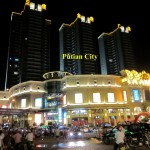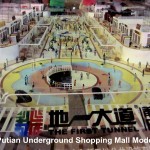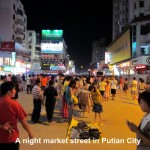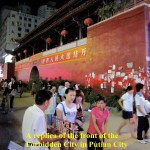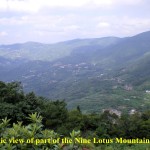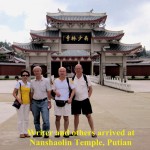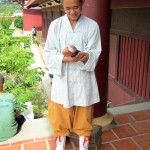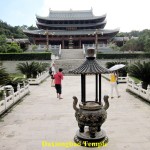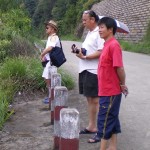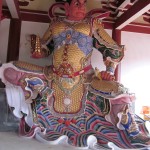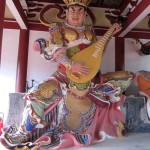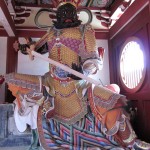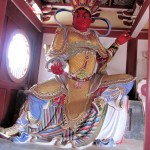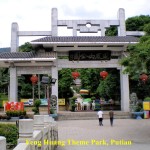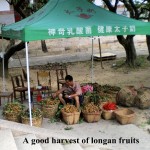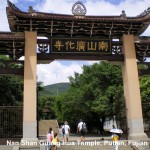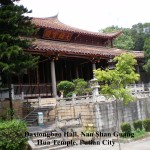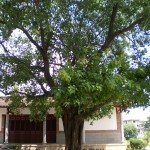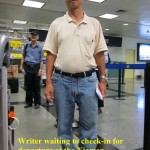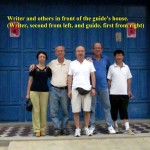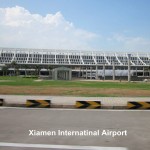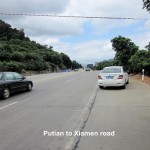China Relatives and Ancestral Places III (Putian, Fujian Province)
Filed under: China Relatives and Ancestral Places III (Putian in Fujian Province), China(Relatives)
(Continued from China Realtives and Ancestral Places II)
At 2 p.m. we left the island in the same old boat that it had brought us to the island in the morning. When the boat was going to leave the pier for the mainland we were shocked to see an old man, suddenly, appeared from nowhere near our boat. He was sitting on a small square polystyrene float with a pair of slippers beside him and kept rowing with a bamboo stick. I thought he was crazy trying to row across the channel to the mainland to save the ferry ticket.
As our boat was moving away from the Meizhou Island towards the mainland, I kept watching him. Then, a few minutes later, I saw him making a U-turn and rowing back to the island. I was amused and felt relieved, but wondered why he was doing that.
Day 5 Tuesday 7 September 2010
Shopping in Hanjiang Town
In the morning, Brother Tan Yun brought us to a trading centre of wholesale shops in Hanjiang Town. Those shops were selling many kinds of things, cheaply, such as tea leaves, dried seafood, apparels, shoes, electrical and electronic products, etc. We spent several hours at a few shops there and bargained with the shopkeepers over the prices of the things we wanted to buy. Inspite of our worries about the quality of the electrical and electronic goods, all of us bought something there. We found that the prices of those goods there, like handphones, MP4 players, i-Robots(like the i-Pad), GPS, etc. were very much cheaper than in my country.
“The First Tunnel”, Putian City
In the evening, we went to Putian City. On arrival in the city centre, we went to a popular night-market street. Besides shops on both sides of that long, wide street, there were hawkers selling merchandise in the in the middle of it.
While we were there we were appalled at the sight of the street. It was dusty and dirty, and large holes were everywhere. Later, we discovered that an underground shopping mall was under construction. It was to be known as “The First Tunnel”.
Workers were working round the clock, digging below the street, removing the earth and pumping dirty water out of the tunnel onto the street. Besides, lorries came to load and take away the earth, and other lorries came to deliver mortars for the underground structures.
When we reached the end of the street we saw a red wall which looked like the front gate of the Forbidden City in Beijing, but it was smaller and without a photo of Chairman Mao Tze Dong. Then we left the street for Brother Tan Yun’s house in Tie Zao Village in Nanxing and near Hanjiang Town.
Day 6 Wednesday 8 September 2010
Nanshaolin Temple, Putian, Fujian Province
In the morning, we went to a Buddhist temple, Nanshaolin Temple, which is 58 km north of Putian City. It is well-known for a Chinese martial art, Wushu. Located in a basin at a height of about 600 metres and surrounded by nine mountains known as Nine Lotus Mountains(Jiulian Shan), the original temple was built in A.D. 557. Later, during the war between the two dynasties, Qing and Ming, it was burnt down by the former troops.
In 1998, the Fujian Province government spent more than RMB 80 millions to rebuild and enlarge the Nanshaolin Temple site. Now it covers an area of about 20 hectares attracting lots of visitors from near and far.
To go to the temple, we had to drive up a long but winding road. While travelling up the mountains, we could see
beautiful sceneries of the mountains, lowlands and the city of Putian in the distance. On arrival at the temple, we were greeted by a large arch with four Chinese characters which told us that it was Nanshaolin Temple(or South Shaolin Temple). Besides being a Buddhist temple, monastery and religious school, Nanshaolin Temple is a world well-known Chinese martial art(Wushu) training school for both young and old enthusiasts. There are many beautiful bright-coloured buildings of worship there. But the most important one is the largest shrine known as Daxiongbao Temple which houses three large golden statues of Lord Buddha and 18 small golden statues of monks.
There is one building where a large statue of smiling Buddha is placed in the middle and watched by four large statues of fearsome looking figures. They are known as “The Four Heavenly Kings”(“Si Da Tianwang” in Chinese). They are called:
a. The Heavenly King of the North
He holds a pagoda in his right hand and a pet in his left one.
b. The Heavenly King of the East
He plays a Chinese musical instrument known as “pi-pa”.
c. The Heavenly King of the South
He has a black face and holds a sword.
d. The Heavenly King of the West
He holds a dragon in his right hand and a golden pearl in his left hand.
According to the Buddhist faith, the four heavenly kings are Buddha’s protectors. Besides, each of them watches over a cardinal direction of the world(East, West, North or South), and they are believed to protect the world form evils.
Feng Huang Theme Park, Putian
After an interesting tour of the world famous Nanshaolin Temple, we descended the mountain and headed for a theme park known as Feng Huang Theme Park or Phoenix Theme Park in Putian City. This is a place where there are 15 exciting activities, such as riding a large swinging pirate boat, sitting in aeroplanes that go round and round, encountering ghosts in a cave, riding bumper cars, pedalling boats in a lake, ice-skating, riding mechanical horses, etc. On arrival at the park, we all decided not to enter the park as we were tired and the day was hot. Besides, we felt too old for those activities.
After a few minutes of looking around the place outside the theme park, we left and went to a well-known Buddhist temple which is 3 km south of Putian City. It is known as Nan Shan Guang Hua Temple.
Nan Shan Guang Hua Temple, Putian City
This temple is located at the foot of Nan Shan or Feng Huang (Phoenix) Mountain. It was first built in 558 A.D. as a Buddhist monastery. It has a long history of over 1,400 years of good and bad times. It enjoyed the best time during the Song Dynasty(960-1279) when it had about 1,000 monks and nuns. It was once destroyed by fire during a war in the Yuan Dynasty(1271-1368), but it was restored in the Ming Dynasty(1368-1644).
During the Cultural Revolution(1966-1976), all the Buddhist statues were destroyed and the monks were expelled from the temple. Then it was turned into a factory. After the revolution, the Chinese government allowed the temple to be reopened. With donations pouring in from overseas Chinese, it was rebuilt in 1984 with more religious buildings giving it a new look. The main building is known as Daxiongbao Hall. It now covers a large area of 40,000 sq. metres.
Bodhi Tree
When we entered the temple site, we were amazed to see a lot of longan trees which were bearing fruits then. The trees made the site a cooling place during the hot day then. Besides, there was a tall Bodhi tree outside the temple. That tree is significant to Buddhists as they believe that Buddha achieved
enlightenment when he was under a large Bodhi tree in India.
After a tour of the serene Guang Hua Temple, we left for late lunch and returned to Brother Tan Yun’s house to rest our tired bodies.
Day 7 Thursday 9 September 2010
Departure for Malaysia
We had to leave China today. In the morning, we thanked our hosts for their kind hospitality. They had allowed us to stay at their large mansion in a small village, Tie Zao, in Nanxing near Hanjiang Town for the last four days. Then our good guide, Brother Tan Yun, drove us in his car to Xiamen Airport to catch a flight home, Malaysia. We had missed our families in the country for the last seven days.
After traveling on the well-built expressway from Hanjiang for two hours we finally reached the airport. At the airport, we thanked and bade farewell to Brother Tan Yun. He hoped that we would come back again to visit him and our relatives for a longer period.
In the evening, we, finally, left the Xiamen Airport for home bringing back with us rich memorable experiences of our first visit to our relatives and their villages in Fujian Province in China. Our tour guide, Brother Tan Yun, our tour guide, has done us a good service and we will always remember him.



